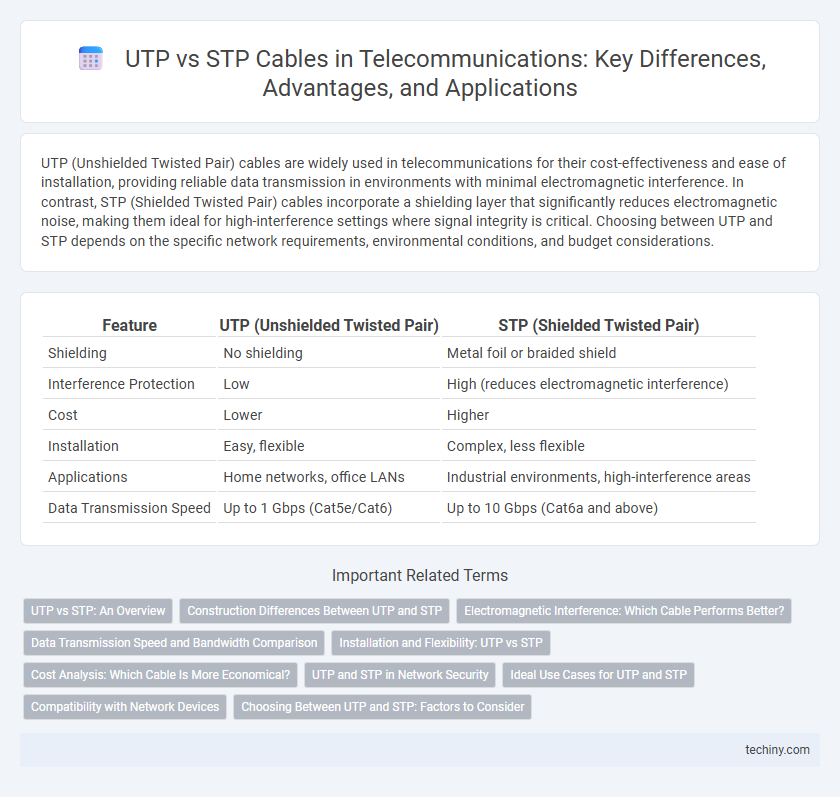UTP (Unshielded Twisted Pair) cables are widely used in telecommunications for their cost-effectiveness and ease of installation, providing reliable data transmission in environments with minimal electromagnetic interference. In contrast, STP (Shielded Twisted Pair) cables incorporate a shielding layer that significantly reduces electromagnetic noise, making them ideal for high-interference settings where signal integrity is critical. Choosing between UTP and STP depends on the specific network requirements, environmental conditions, and budget considerations.
Table of Comparison
| Feature | UTP (Unshielded Twisted Pair) | STP (Shielded Twisted Pair) |
|---|---|---|
| Shielding | No shielding | Metal foil or braided shield |
| Interference Protection | Low | High (reduces electromagnetic interference) |
| Cost | Lower | Higher |
| Installation | Easy, flexible | Complex, less flexible |
| Applications | Home networks, office LANs | Industrial environments, high-interference areas |
| Data Transmission Speed | Up to 1 Gbps (Cat5e/Cat6) | Up to 10 Gbps (Cat6a and above) |
UTP vs STP: An Overview
Unshielded Twisted Pair (UTP) cables offer cost-effective and flexible wiring for most Ethernet networks, delivering reliable data transmission with minimal interference in controlled environments. Shielded Twisted Pair (STP) cables incorporate an additional shielding layer, significantly reducing electromagnetic interference (EMI) and crosstalk, making them ideal for industrial or high-interference settings. Choosing between UTP and STP depends on the network environment, budget constraints, and the need for enhanced protection against noise and signal degradation.
Construction Differences Between UTP and STP
UTP (Unshielded Twisted Pair) cables consist of pairs of insulated copper wires twisted to reduce electromagnetic interference without additional shielding, making them lightweight and flexible. STP (Shielded Twisted Pair) cables incorporate an extra conductive shield, such as foil or braided metal, around the wire pairs or the entire cable to provide enhanced protection against external electromagnetic interference and crosstalk. The presence of shielding in STP results in a thicker, more rigid cable construction compared to the simpler, more pliable design of UTP.
Electromagnetic Interference: Which Cable Performs Better?
STP (Shielded Twisted Pair) cables perform better than UTP (Unshielded Twisted Pair) cables in minimizing electromagnetic interference (EMI) due to their additional shielding layer that blocks external noise sources. UTP cables, lacking this shielding, are more susceptible to EMI, making STP the preferred choice in environments with high electromagnetic disturbances. This improved EMI resistance enhances signal quality and reduces data transmission errors in complex telecommunications installations.
Data Transmission Speed and Bandwidth Comparison
Unshielded Twisted Pair (UTP) cables generally support data transmission speeds up to 10 Gbps, with bandwidth capabilities typically reaching 100 MHz, making them suitable for standard Ethernet networks. Shielded Twisted Pair (STP) cables, featuring additional shielding to reduce electromagnetic interference, can maintain higher data transmission speeds and support bandwidths exceeding 600 MHz, thus enhancing performance in environments with significant electrical noise. The improved interference resistance of STP cables enables more reliable high-speed data transfers over longer distances, which is crucial for high-bandwidth applications and industrial telecommunications setups.
Installation and Flexibility: UTP vs STP
UTP cables offer easier installation and greater flexibility due to their lighter weight and thinner insulation, making them ideal for complex routing in telecommunications networks. STP cables, with their additional shielding, require more careful handling and precise grounding, which can increase installation time and complexity. In environments where electromagnetic interference is a concern, the increased installation challenges of STP are justified by improved data integrity.
Cost Analysis: Which Cable Is More Economical?
UTP (Unshielded Twisted Pair) cables are generally more cost-effective due to their lower material and installation expenses compared to STP (Shielded Twisted Pair) cables, which require additional shielding materials and grounding efforts. The price difference is significant in large-scale deployments where the budget constraints prioritize cable volume over specialized interference resistance. Evaluating total cost of ownership, UTP cables offer savings on both initial purchase and maintenance, making them the preferred choice for most standard telecommunications applications.
UTP and STP in Network Security
Unshielded Twisted Pair (UTP) cables are widely used in telecommunications for their cost-effectiveness and ease of installation but offer limited protection against electromagnetic interference and eavesdropping, impacting network security. Shielded Twisted Pair (STP) cables incorporate a conductive shield to minimize signal interference and enhance data integrity, making them more suitable for secure network environments. Choosing STP over UTP improves resistance to external noise and reduces vulnerability to interception, thereby strengthening overall network security in sensitive telecommunications applications.
Ideal Use Cases for UTP and STP
UTP (Unshielded Twisted Pair) cables are ideal for residential and office environments where electromagnetic interference is minimal, offering cost-effective and easy installation for data transmission and voice communication. STP (Shielded Twisted Pair) cables excel in industrial settings, data centers, and high-interference areas, providing enhanced protection against electromagnetic and radio frequency interference to maintain signal integrity. Choosing UTP suits general networking needs, while STP is preferred for environments requiring superior noise reduction and reliable performance.
Compatibility with Network Devices
Unshielded Twisted Pair (UTP) cables offer broad compatibility with most network devices due to their widespread use in Ethernet standards such as Cat5e and Cat6. Shielded Twisted Pair (STP) cables require devices and connectors that support grounding and shielding to fully leverage their interference protection capabilities. Network environments with high electromagnetic interference may favor STP for enhanced signal integrity, but ensuring device compatibility is essential for optimal performance.
Choosing Between UTP and STP: Factors to Consider
Choosing between UTP (Unshielded Twisted Pair) and STP (Shielded Twisted Pair) cables depends on factors such as electromagnetic interference (EMI) levels, cost, and installation environment. UTP cables are more cost-effective and easier to install, making them ideal for typical office settings with minimal EMI, while STP cables provide superior protection against EMI by incorporating shielding, which is essential for industrial or high-interference areas. Consider network speed requirements, cable length limitations, and budget constraints to determine the optimal cable type for reliable and efficient telecommunications connectivity.
UTP vs STP Infographic

 techiny.com
techiny.com